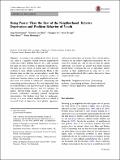Files in this item
Being poorer than the rest of the neighborhood : relative deprivation and problem behavior of youth
Item metadata
| dc.contributor.author | Nieuwenhuis, Jaap | |
| dc.contributor.author | Van Ham, Maarten | |
| dc.contributor.author | Yu, Rongqin | |
| dc.contributor.author | Branje, Susan | |
| dc.contributor.author | Meeus, Wim | |
| dc.contributor.author | Hooimeijer, Pieter | |
| dc.date.accessioned | 2017-08-30T14:30:07Z | |
| dc.date.available | 2017-08-30T14:30:07Z | |
| dc.date.issued | 2017-09 | |
| dc.identifier | 250962431 | |
| dc.identifier | fd99137a-b6dd-424f-bdcb-7003cfeb75fa | |
| dc.identifier | 85016604857 | |
| dc.identifier | 000407995500003 | |
| dc.identifier.citation | Nieuwenhuis , J , Van Ham , M , Yu , R , Branje , S , Meeus , W & Hooimeijer , P 2017 , ' Being poorer than the rest of the neighborhood : relative deprivation and problem behavior of youth ' , Journal of Youth and Adolescence , vol. 46 , no. 9 , pp. 1891-1904 . https://doi.org/10.1007/s10964-017-0668-6 | en |
| dc.identifier.issn | 0047-2891 | |
| dc.identifier.other | crossref: 10.1007/s10964-017-0668-6 | |
| dc.identifier.other | ORCID: /0000-0002-2106-0702/work/64697480 | |
| dc.identifier.uri | https://hdl.handle.net/10023/11571 | |
| dc.description | The research leading to these results has received funding from the European Research Council under the European Union’s Seventh Framework Programme (FP/ 2007-2013)/ERC Grant Agreement n. 615159 (ERC Consolidator Grant DEPRIVEDHOODS, Socio-spatial inequality, deprived neighbourhoods, and neighbourhood effects), from the Marie Curie programme under the European Union’s Seventh Framework Programme (FP/2007-2013)/Career Integration Grant n. PCIG10-GA-2011- 303728 (CIG Grant NBHCHOICE | en |
| dc.description.abstract | According to the neighborhood effects hypothesis, there is a negative relation between neighborhood wealth and youth’s problem behavior. It is often assumed that there are more problems in deprived neighborhoods, but there are also reports of higher rates of behavioral problems in more affluent neighborhoods. Much of this literature does not take into account relative wealth. Our central question was whether the economic position of adolescents’ families, relative to the neighborhood in which they lived, was related to adolescents’ internalizing and externalizing problem behavior. We used longitudinal data for youth between 12–16 and 16–20 years of age, combined with population register data (N = 926; 55% females). We employ between-within models to account for time-invariant confounders, including parental background characteristics. Our findings show that, for adolescents, moving to a more affluent neighborhood was related to increased levels of depression, social phobia, aggression, and conflict with fathers and mothers. This could be indirect evidence for the relative deprivation mechanism, but we could not confirm this, and we did not find any gender differences. The results do suggest that future research should further investigate the role of individuals’ relative position in their neighborhood in order not to overgeneralize neighborhood effects and to find out for whom neighborhoods matter. | |
| dc.format.extent | 650430 | |
| dc.language.iso | eng | |
| dc.relation.ispartof | Journal of Youth and Adolescence | en |
| dc.subject | Neighborhood effects | en |
| dc.subject | Externalizing problems | en |
| dc.subject | Internalizing problems | en |
| dc.subject | Parent–adolescent conflict | en |
| dc.subject | Relative deprivation | en |
| dc.subject | Residential mobility | en |
| dc.subject | GF Human ecology. Anthropogeography | en |
| dc.subject | NDAS | en |
| dc.subject.lcc | GF | en |
| dc.title | Being poorer than the rest of the neighborhood : relative deprivation and problem behavior of youth | en |
| dc.type | Journal article | en |
| dc.contributor.sponsor | European Research Council | en |
| dc.contributor.institution | University of St Andrews. School of Geography & Sustainable Development | en |
| dc.identifier.doi | 10.1007/s10964-017-0668-6 | |
| dc.description.status | Peer reviewed | en |
| dc.identifier.grantnumber | ERC-2013-CoG | en |
This item appears in the following Collection(s)
Items in the St Andrews Research Repository are protected by copyright, with all rights reserved, unless otherwise indicated.

